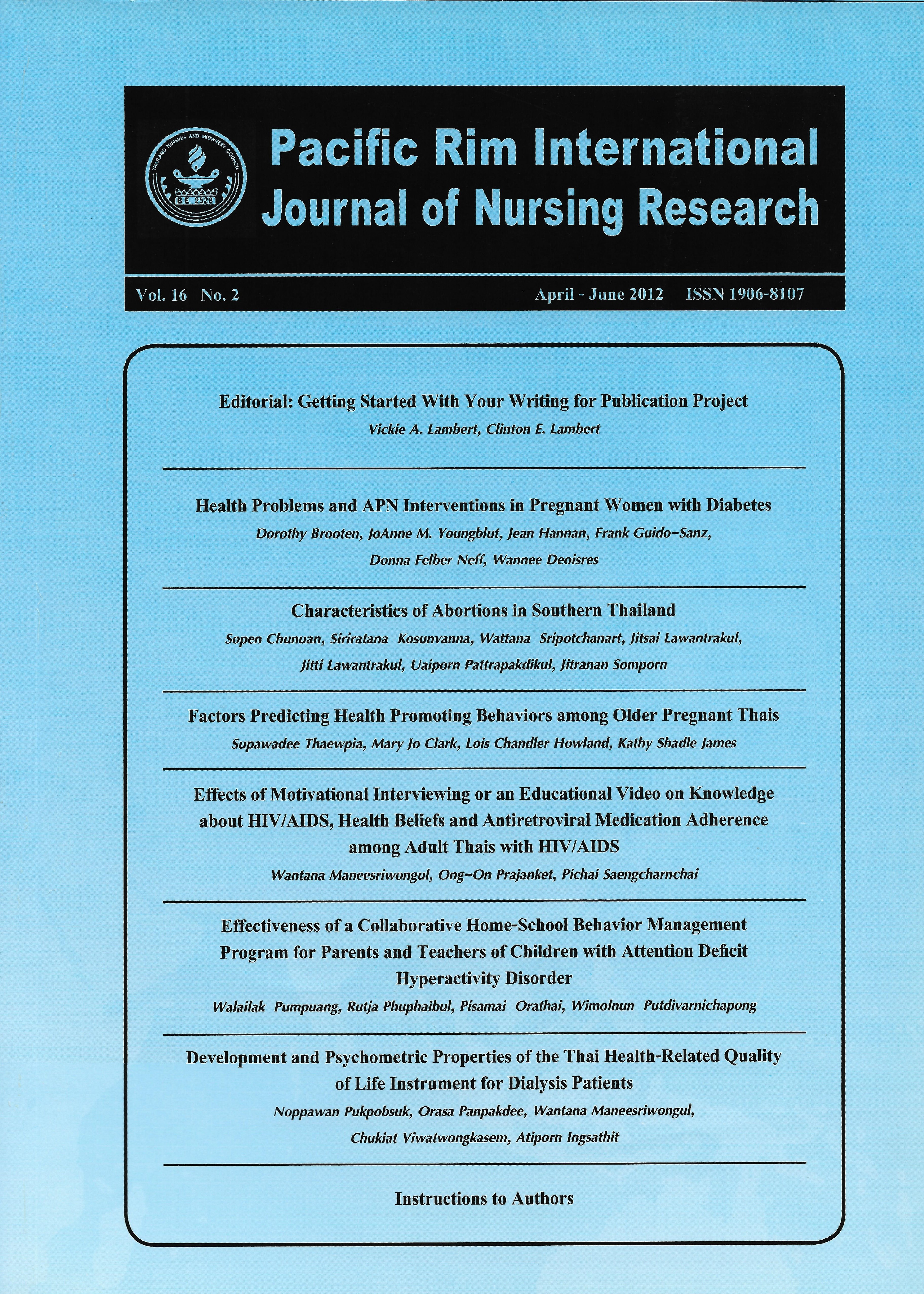Characteristics of Abortions in Southern Thailand
Keywords:
แท้ง, สตรีไทย, การยุติการตั้งครรภ์, การแท้งไม่ปลอดภัย, Abortion, Thai women, Pregnancy termination, Unsafe abortionsAbstract
บทคัดย่อ
การศึกษาเชิงบรรยายครั้งนี้มีวัตถุประสงค์เพื่อรวบรวมข้อมูลของสตรีหลังแท้งซึ่งเป็นแท้งเองการทำแท้งเพื่อการรักษา หรือการทำแท้งที่ไม่ปลอดภัย จำนวน 402 ราย ในภาคใต้ของประเทศไทยโดยศึกษาเกี่ยวกับประวัติการตั้งครรภ์ อุบัติการณ์ของการแท้งและค่ารักษาพยาบาล ผลกระทบที่เกิดจากการแท้งและการรักษาที่ได้รับ; เหตุผลที่ทำให้สตรีเลือกทำแท้งไม่ปลอดภัย; และรายละเอียดที่เกี่ยวข้องกับการทำแท้งไม่ปลอดภัย เก็บข้อมูลโดยใช้แบบสอบถามที่มีลักษณะเป็นโครงสร้าง สถิติที่ใช้ในการวิเคราะห์ข้อมูลเป็นสถิติเชิงบรรยาย
แม้ว่ากลุ่มตัวอย่างร้อยละ 64.3 (n = 259) เป็นสตรีที่แท้งเอง (n = 238) หรือทำแท้งเพื่อการรักษา(n = 21) และร้อยละ 35.7 (n = 143) ของกลุ่มตัวอย่างทั้งหมดเป็นสตรีที่ทำแท้งไม่ปลอดภัย สตรีหลังแท้งให้เหตุผลของการทำแท้งไม่ปลอดภัยว่าเกิดจากปัญหาทางด้านสังคม (ไม่พร้อมจะมีบุตรร้อยละ 60.8,ตั้งครรภ์ก่อนสมรสร้อยละ 24.5, และกำลังศึกษาร้อยละ 23.1) ปัญหาทางด้านเศรษฐกิจ (มีรายได้ไม่เพียงพอร้อยละ 42.7) และ/หรือปัญหาทางด้านครอบครัว (กลัวครอบครัวอับอายร้อยละ 16.8 หรือมีบุตรเพียงพอแล้วร้อยละ 16.1) กลุ่มตัวอย่างรายงานว่ามีอาการปวดท้องรุนแรง (n = 64; ร้อยละ 44.8) มีไข้ (n = 55; ร้อยละ38.5) มีภาวะซีด (n = 25; ร้อยละ 17.5) และมีภาวะช็อกร้อยละ 7.0 (n = 10) สตรีหลังแท้งมากกว่าหนึ่งในสาม (n = 53; ร้อยละ 37.1) มีผลกระทบด้านจิตใจเพียงอย่างเดียวคือไม่มีปัญหาทางด้านสังคมและเศรษฐกิจร่วมด้วย สตรีส่วนใหญ่ที่ทำแท้งไม่ปลอดภัยตัดสินใจ ยุติการตั้งครรภ์ด้วยตนเอง (n = 115;ร้อยละ 80.4) และสตรีหลังทำแท้งไม่ปลอดภัยร้อยละ 49 (n = 70) ทำแท้งด้วยตนเอง
จากการศึกษาครั้งนี้พบว่าสตรีหลังทำแท้งไม่ปลอดภัยส่วนใหญ่ประสบกับปัญหาทั้งทางด้านร่างกาย จิตใจ และเศรษฐกิจ ผลการศึกษาครั้งนี้จะเป็นข้อมูลพื้นฐานสำหรับเจ้าหน้าที่สาธารณสุขในการจัดบริการให้คำปรึกษาและโปรแกรมการดูแลที่เกี่ยวข้องกับการยุติการตั้งครรภ์จากการตั้งครรภ์ที่ไม่พึงประสงค์ ซึ่งโปรแกรมหรือบริการที่พัฒนาขึ้นนี้จะเป็นประโยชน์สำหรับสตรีตั้งครรภ์ได้ใช้ประกอบในการตัดสินใจเกี่ยวกับการดูแลสุขภาพ และพัฒนาคุณภาพชีวิตของตนเอง
คำสำคัญ: แท้ง; สตรีไทย; การยุติการตั้งครรภ์; การแท้งไม่ปลอดภัย
Abstract
The purposes of this descriptive study of 402 women from southern Thailand,who had undergone a recent abortion (spontaneous, therapeutic and unsafe), were to obtaindata regarding their: pregnancy history; number of abortions and cost of abortion relatedtreatments; abortion complications, impacts and related health care services; reasonsfor having an unsafe abortion; and, circumstances related to an unsafe abortion. Data werecollected via use of a structured questionnaire and analyzed using descriptive statistics.
Even though 64.3% (n = 259) of the women had either a spontaneous (n = 238) ortherapeutic (n = 21) abortion, 35.7% (n = 143) of them had undergone an unsafe abortion.They reported having an unsafe abortion due to: a social problem (not ready for a baby = 60.8%;being unmarried = 24.5%; or, being a student = 23.1%); a financial problem (insufficientincome = 42.7%); a family problem (fear of family members being embarrassed = 16.8%;and/or, having enough children 6.1%). They complained, post-abortion, of having experienced:abdominal pain (n = 64; 44.8%); fever (n = 55; 38.5%); anemia (n = 25; 17.5%); and, shock(n = 10; 7.0%). Over one-third (n = 53; 37.1%) of them experienced psychological problemsthat did not include social or economic issues. Most (n = 115; 80.4%) of those who hadan unsafe abortion reported making their own decisions regarding termination of thepregnancy, with 49% (n = 70) indicating they performed their own abortion.
Since the majority of women who had experienced an unsafe abortion wereconfronted with physical, psychological and economical problems, it behooves healthcare providers to offer counseling services and programs regarding the termination ofan unwanted pregnancy. Such services and programs could help pregnant women makeinformed decisions regarding their health and quality of life.
Keywords: Abortion; Thai women; Pregnancy termination; Unsafe abortions
Downloads
How to Cite
Issue
Section
License
Copyright: The Pacific Rim International Journal of Nursing Research, Thailand Nursing & Midwifery Council has exclusive rights to publish, reproduce and distribute the manuscript and all contents therein.








.png)



